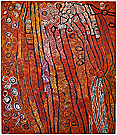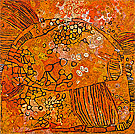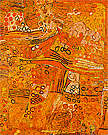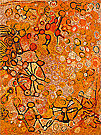Naata NUNGURRAYI
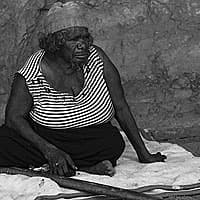
I am painting my home, my Country—women’s Kanaputa story. Travelling along Irrututu, Tjuntupul, Marrapinti, Ngami, Wirrul. A long time ago, I travelled all around this Country, from place to place. I was a young girl at Marrapinti. Walking with my family and two sisters. I came to Marrapinti as a young mother. Travelling with my son Kenny, who was born at Liki. Later, we travelled west to Unkunya, where my other son, Titji, was born. I lost my last child, my daughter, at Unkunya and my husband at Yumurru. It was dry and hot times. We walked east, all the way to Pinpirrnga, drinking from rockholes, sleeping on ground with windbreaks. We then walked to Amunturrngu (Mount Liebig), where we saw the windmill and speared a bullock. After that, we followed the road to Papunya.
Today, I am living in Kintore with my family, sitting down with my grandchildren. I have lost my two sisters. I am the only one. Painting my home. Painting Marrapinti—women travelling, sandhills, rockholes. They pierced their noses at Marrapinti, like this [Nungurrayi gestures to her nose]. Sitting in the cave. Putting little kangaroo bones through their nose. Singing the Tjukurrpa (Dreaming) from a long time ago, singing that Marrapinti.[1]
Naata Nungurrayi is a Pintupi artist born in 1930 at Kumil, a rockhole west of Pollock Hills, near the present-day community of Kiwirrkurra in Western Australia. Nungurrayi lived a traditional lifestyle until she, along with her family, came out of the bush in 1964, meeting up with a native welfare patrol before moving to the settlement of Papunya in the Northern Territory. She later moved to Walungurru (Kintore) in the Northern Territory, when it was established as an outstation in the early 1980s. Kintore is where she currently resides.[2]
In 1971, the Papunya art movement was established by the male artists in the community. For the first three years, they painted on small boards. By the end of the 1970s, they had progressed to painting on large canvases, often with the assistance of kin, including their wives, although the latter were rarely acknowledged or attributed. Women at Papunya, apart from some notable exceptions, did not make paintings for the public—that is, until a women’s program was developed in 1994, providing an artistic outlet and a source of income. However, it was not until 1996 that Nungurrayi started painting for the Papunya Tula Artists cooperative.
Throughout her career Nungurrayi has developed a distinctive colour palette primarily featuring white, reds, blacks, yellows, oranges and pinks. Her fine dots form bold lines to create the interconnecting lines of the tali (sandhills) of her Country, giving her paintings movement and form. The topographical view of Country in multiple layers of colour and designs gives a strong sense of the sandhills and evoke Nungurrayi’s deep cultural and geographical knowledge of her Country.
Central to Nungurrayi’s paintings are traditional women’s law, ceremony (the Tingari cycle in particular), ancestral stories and, importantly, her Country. The Tingari are ancestral men and women who created sites of significance as they travelled great distances throughout their Country. The men would travel first, followed closely by the women. Today, songlines are sung as an important reminder of their stories and adventures. Nungurrayi’s works identify specific water-soakage sites—including Marrapinti, a sacred waterhole west of Pollock Hills, and several sites around Kiwirrkurra, such as Wanku, Piti Kutjarra, Ngaripunkunya, Ngaminya and Wirrulnga. The surrounding tali, puli (rocky outcrops) and punti (vegetation) often feature in ancestral stories and refer to the resting places of the ancestral women on their travels.
Nungurrayi’s square-shaped Untitled 2010 is associated with Unkunya, another water-soakage site west of Pollock Hills. Long ago, two ancestor snakes travelled through this site from far in the east. When they travelled underground, they formed the soakages at Unkunya. Coming from the west, many ancestral women would travel through this site, digging for water before heading to the east. They would also stop at Marrapinti, where they would make nose bones (worn in the nasal septum) called marrapinti. Nose bones were once worn by both men and women of all ages, but now are only worn by Elders during ceremonies. Travelling to the east, the women would pass through Ngaminya and Wirrulnga to gather kampurarrpa (desert raisins or bush tomatoes). The berries, although sometimes eaten direct from the plant, are often ground into dough and cooked like damper.
Nungurrayi is a well-respected artist and Elder whose paintings evoke the depth and beauty of her Country, culture and ancestral stories. Without the artist’s insight her paintings reveal little of their associated stories, but viewers are rewarded aesthetically and, once the stories are revealed, culturally.
Tina Baum
[1]Naata Nungurrayi, in conversation with Marlene Nampitjinpa and Sarita Quinlivan, October 2010.
[2]2 Ian McLean, ‘Naata Nungurrayi’, Western Australian Indigenous Art Awards: 2008, Art Gallery of Western Australia, Perth, 2008, pp 0–1.

